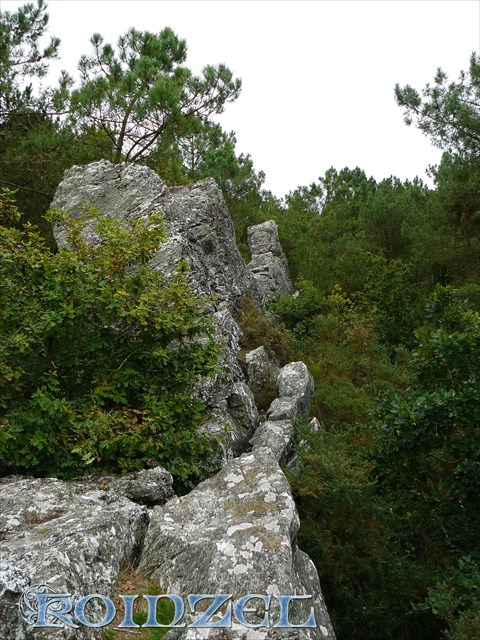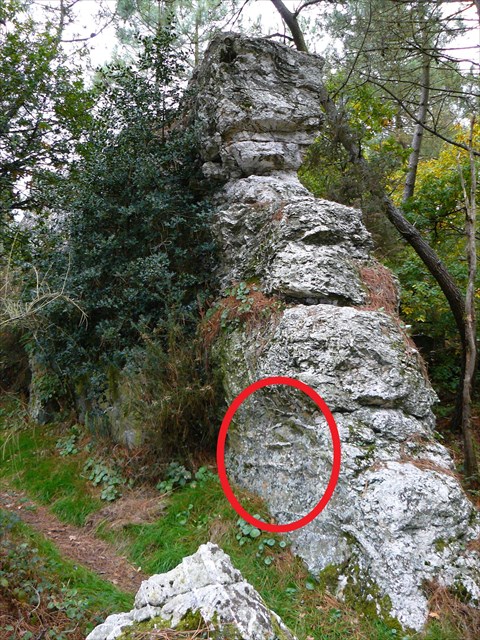Les Rochers de Saint-Méen EarthCache
Les Rochers de Saint-Méen
-
Difficulty:
-

-
Terrain:
-

Size:  (other)
(other)
Please note Use of geocaching.com services is subject to the terms and conditions
in our disclaimer.
Dans les Landes de Saint-Méen à la Chapelle-Caro, une étrange et impressionnante muraille se dresse en plein cœur de la forêt telle les ruines d'une ancienne forteresse. L'homme n'y est cependant pour rien et c'est un filon de quartz qui explique cette formation géologique d'un intérêt départemental : les Rochers de Saint-Méen.
In the Landes Saint-Meen in Chapelle- Caro, a strange and impressive wall stands in the heart of the forest as the ruins of an ancient fortress . The man , however, is there for nothing and it is a quartz vein that explains the geological formation of a county interest: the Rock of Saint-Méen.

Les rochers de Saint-Méen
Le quartz ( dioxyde de silicium - SiO2 ) est un minéral extrêmement commun que l'on retrouve dans de nombreuse roches mais également en filon d'origine hydrothermale.
Quartz ( silicon dioxide - SiO2 ) is a very common mineral that is found in rocks, but also large vein of hydrothermal origin .
La formation de ce mur s'explique grâce à la géomorphologie. Nous avons ici un schiste ( roche métamorphique ) qui constitue notre roche de base, où des failles sont apparues sous l'effet de contraintes tectoniques. De l'eau à haute température et sous pression, chargée d'éléments minéraux, s'est ensuite infiltrée par ces failles où peu à peu s'est cristallisé le filon de quartz. Or le quartz à la particularité d'être un minéral très dur ( 7 sur l’échelle de Mohs ). Le temps et l'érosion ont donc dégagé et mis en relief ce filon de quartz, formant aujourd'hui un véritable mur dans le paysage.
The formation of this wall is explained by geomorphology. Here we have a schist ( metamorphic rock ) which is our basic rock where fracture have arisen as a result of tectonic stress . Water at high temperature and under pressure, full of minerals , was then infiltrated by these faults which gradually crystallized quartz vein . But the quartz has the particularity to be a very hard mineral ( 7 on the Mohs scale ) . Time and erosion have therefore cleared and highlighted the quartz vein , now forming a real wall in the landscape.

Schéma de formation du mur
D'après la légende, c'est du haut de ce promontoire que Saint-Méen est venu prêcher les foules au VIe siècle, d'où les noms que porte la curieuse muraille : La Chaire de Saint-Méen ou château de Saint-Méen. D'un autre côté, la légende raconte aussi que l'un des rochers, ressemblant à un dolmen, est appelé le berceau du diable. On y voit dans un autre, en creux, le bénitier du diable.
According to legend, this is on the top of the promontory where Saint-Meen preach to the crowds in the sixth century , giving the wall curious name: The Chair of St. -Méen or Castle St. Meen . On the Other Side of the UN , legend aussi That UN rocks, like a dolmen UN EST Called the cradle of the devil. It Sees In Other UN hollow , the font of the devil.
Pour valider votre découverte, rendez-vous aux coordonnées indiquées afin de questions suivantes dont vous m'adresserez les réponses soit via mon profil, soit via la messagerie geocaching.com :
Question n°1: Quelle est la couleur des veines de quartz?
Question n°2: Quelle est la hauteur approximative du mur à cet endroit?
Question n°3: Dans la zone entourée en rouge sur la photo suivante, quelle est la largeur des veines de quartz et le distance les séparant ?
Question n°4: Quelle est la longueur approximative du mur ? Précisez-moi la méthode que vous avez employé pour la définir.
To validate your discovery , move to the waypoint coordinate then answer the following questions which you will address me the answers by my profile or by Message Center geocaching.com :
Question n°1: What Is the color of the quartz veins ?
Question n°2: What is the approximate height of the wall there?
Question n°3: In the area circled in red in the following picture , how wide quartz veins and the distance between them?
Question n°4: What is the approximate length of the wall ? Specify me the method you used to set.

A vos mesures
|

Additional Hints
(No hints available.)